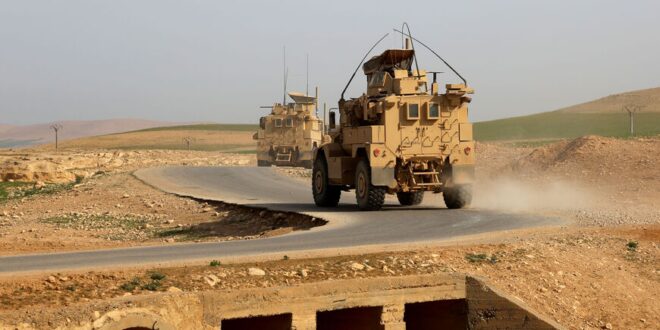New rocket and drone attacks targeted US bases in Syria in the hours following the latest US airstrikes designed to dissuade the IRGC and its militias from continuing their attacks on American personnel.
Bases used by the US military in Syria have come under four separate rocket and drone attacks since Washington authorized the third round of precision airstrikes against facilities used by Iran’s Islamic Revolutionary Guard Corps (IRGC) and associated militias in eastern Syria on Sunday night, a US official confirmed to Al-Monitor.
Shortly after the US strikes on Sunday evening, “a multi-rocket attack” targeted the US-led coalition, Mission Support Site-Euphrates, in Syria’s far east.
US troops at the Green Village base near Syria’s al-Omar oilfield in Deir Ezzor province and the US-led coalition base at Shaddadi also were targeted each by a one-way attack drone on Sunday night, the official said. Both of those drones were shot down before striking the bases.
The drumbeat of attacks continued into Monday, as “multiple one-way drones” targeted the coalition base at Rumalyn Landing Zone, according to the US official. One of those drones was shot down while the other impacted the base, causing infrastructure damage to four tents.
No injuries were reported. The US official spoke on the condition of anonymity to divulge the latest accounting of the attacks.
Why it matters: Washington’s bid to deter the attacks by launching precision airstrikes against IRGC-linked facilities in Syria appears to have failed to achieve its objectives once again.
On Sunday night, US warplanes struck a training facility near Albukamal on Syria’s eastern desert border with Iraq; a “safe house” near the city of al-Mayadin, which lies further up the Euphrates from the border, was also struck. Both of the sites were used by the IRGC and militias it backs, officials said.
Roughly 900 US troops remain in Syria with an additional 2,500 in Iraq in the aftermath of the US-led multinational campaign to destroy the Islamic State group, according to numbers the Pentagon has previously made public.
US positions in both countries have come under projectile attack by suspected Iran-backed militias at least 52 times since such attacks kicked off on Oct. 17, the aforementioned US official said.
The militias’ resumption of small-scale but nonetheless potentially lethal attacks on US bases in the region ruptured a more than six-month lull in hostilities as IRGC-backed groups ramped up public threats against the US military presence in the region.
Online media fronts thought to be associated with the IRGC-backed militias have publicly linked the threats to Washington’s support for Israel’s ongoing war effort to destroy Hamas, another Iran-backed militant group based in the Gaza Strip.
The Pentagon has striven to underscore the distinct nature of the two conflicts, as President Joe Biden and senior US officials openly warned Iran and its proxies not to take advantage of the war in Gaza to launch their own attacks.
The United States has deployed two aircraft carrier strike groups, additional fighter and strategic bombers, and other lethal assets to the Middle East in a bid to dissuade Iran’s proxies from taking up arms to spread the conflict, which officials have said could potentially draw the United States into a regional war.
Israel kicked off its war in the Gaza Strip to destroy Hamas in response to the Oct. 7 terrorist rampage by the Islamist militant group whose fighters killed at least 1,200 people across southern Israel in an unprecedented breakout of the besieged Palestinian enclave.
The Pentagon sent advisers and a steady flow of armaments to Israel to facilitate its campaign against Hamas in Gaza.
What’s next: International outcry continues to grow against the mounting killing of civilians in Israel’s campaign, but Washington is not backing calls for a cease-fire just yet as the IDF has only just begun to push into Gaza City to hunt down Hamas operatives.
The hardest fighting remains yet to come, former senior military officials tell Al-Monitor, as the IDF prepares to penetrate block-by-block Hamas’ massive network of reinforced underground tunnels.
Israeli Prime Minister Benjamin Netanyahu on Friday publicly rejected US proposals to bring in international forces to manage security in Gaza after the war, as Washington seeks to avoid a drawn-out Israeli occupation that top Pentagon officials see as potentially counterproductive to long-term security.
Know more: The risk for miscalculation remains significant, as Iran’s IRGC has less effective control over the actions of its proxy militias across the region, the former top commander overseeing US forces in the Middle East, retired Army Gen. Joseph Votel, said on Monday.
“I think we’re still relatively early on in the campaign,” Votel explained. For more, listen to the latest episode of Al-Monitor’s On the Middle East podcast, hosted this week by Amberin Zaman and Jared Szuba.
 Eurasia Press & News
Eurasia Press & News


